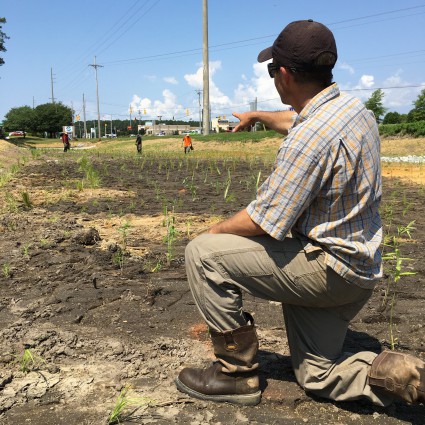
CAPE CARTERET — The N.C. Coastal Federation’s transformation of two Cape Carteret ponds into an innovative, tidal marsh stormwater management system is complete, though people will have an opportunity to add the finishing touches at a community planting Sunday that will also serve as an open house of sorts.
Workers from Backwater Environmental of Pittsboro, implementing a plan developed by Kris Bass of Kris Bass Engineering of Raleigh, put in 18,050 plants, by hand, over a three-day period during the last full week of May.
Supporter Spotlight
That effort finished a project that began over the winter, when Backwater started draining the ponds. Once the drainage was finished, the firm used heavy equipment to dig out layers of muck that had supported growth of water hyacinths, which choked the ponds at the Cape Carteret Baptist and Presbyterian churches, severely curtailing their ability to work effectively to hold and treat stormwater runoff from N.C. 24 and many nearby commercial properties, including a shopping center across the road.
Once the plants were in, Bass said last week, workers removed a filter that had been keeping silt from the project from flowing into Deer Creek, which is connected to the ponds through a culvert. Immediately, he said, countless fish swam into the newly created wetlands, as did crabs.
“It was like they were waiting to get into their new home,” Bass said.
Their new home, Bass said, is a first-of-its-kind stormwater project in North Carolina. Water enters the system in the upper part, on the more westerly Baptist church property, which has been reconstructed to have sand and rock layers below the planted vegetation. It serves as a bio-retention area, filtering as much of the pollutants as possible from the collected stormwater. The treated stormwater then flows underground for 200 feet through a massive rock filter field, before discharging into the new saltwater creek on the Presbyterian property.
The federation hopes that keeping bacteria and other stormwater pollutants out of Deer Creek should preserve and eventually, enhance quality in the waters of the sound.
The nonprofit group that has headquarters just down the road in Ocean is paying for the project, which is estimated to cost about $500,000.
Thursday was warm and sunny, and it hadn’t rained since the weekend, but Bass estimated that 100,000 gallons of freshwater a day were entering the system, although some of it is groundwater. When it rains, the volume will be much higher.

Bass said the tidal range in the eastern end of the system will likely be about two feet, enough to give the carefully selected marsh plants good growing conditions. The freshwater plants at the western end can be kept moist by an engineered system.
All of this, Bass said, will be especially crucial until the marsh is fully established. The plants were spaced at an interval of about two feet.
The soil conditions are good, but Bass said it will probably take two or three growing seasons before the spaces between the plants will fill in with additional vegetation.
A tremendous number of sea shells were found in the muck during excavation, which means the area was almost surely a natural wetland at some point, so it’s a suitable place for a new one to take root and flourish, Bass explained.
Seashells weren’t the only things found in the ponds, either.
Andy Wood of Habitat Environmental Services of Hampstead, hired by the federation, said his company caught and transferred to new homes 93 turtles – snappers and box turtles mostly – 25 frogs and toads and about 300 fish, including a few largemouth bass and plenty of sunfish. They also trapped five American eels and three amphiuma, which are large eel-like salamanders than grow to more than three feet long.
The frogs and toads, eels, amphiuma and fish went to nearby freshwater ponds, although some of the larger fish were held, at least temporarily, at the N.C. Aquarium in Pine Knoll Shores. The turtles went into upstream, freshwater portions of the White Oak River.
As far as he knows, none of the turtles he handled – catching them in bucket traps placed in the ground around the ponds – died.
The critters were hauled to their new homes in buckets and tanks, and the sites were not far away and were approved by the N.C. Wildlife Resources Commission.
Wood believes the turtles will be fine, although some might try to find their way back to the church ponds. “All turtles – terrestrial and sea – have kind of a GPS system, like they’re hooked up to satellites,” he said. “They know where ‘home’ is.”
Lexia Weaver, a federation scientist, said she was more than pleased with the project.
“It looks great, and the contractors went above and beyond to address any issues, anticipated or unanticipated,” she said. “We’ve very excited that all of this stormwater is going to be naturally treated before it enters the creek.”
The whole concept of the project goes back to November 2012 when a water-control structure failed and the water drained into Deer Creek. After discussion with the state, Cape Carteret officials enlisted the federation’s help, and planning began.
Money for the project came from the federation’s 2013 sale of a permanent conservation easement for land at North River Farms to the Natural Resources Conservation Service, a part of the U.S. Department of Agriculture.







